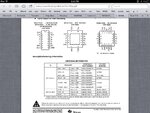wireman121
Newbie level 5

I have been tasked with reproducing a simple LED circuit which consists of 3 PCBs. I am unable to idenfity what the components are doing on the power supply board and was hoping for a little help on it. I am not married to reproducing this circuit verbatim, I just need the same result of controlling the 4 LEDs with either 3 AA batteries or 1 9V battery. I was planning on using Pad2Pad.com to print the boards and digikey for the components, once I know what I am designing here. Any help would be greatly appreciated!








Last edited by a moderator:






